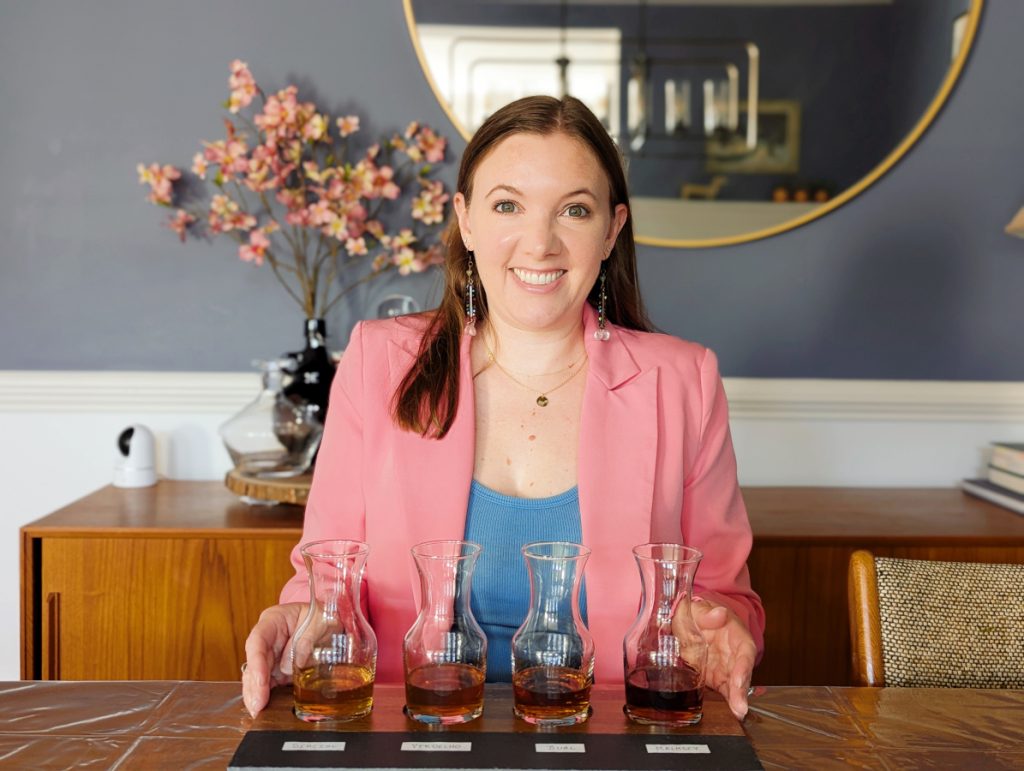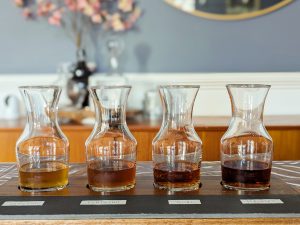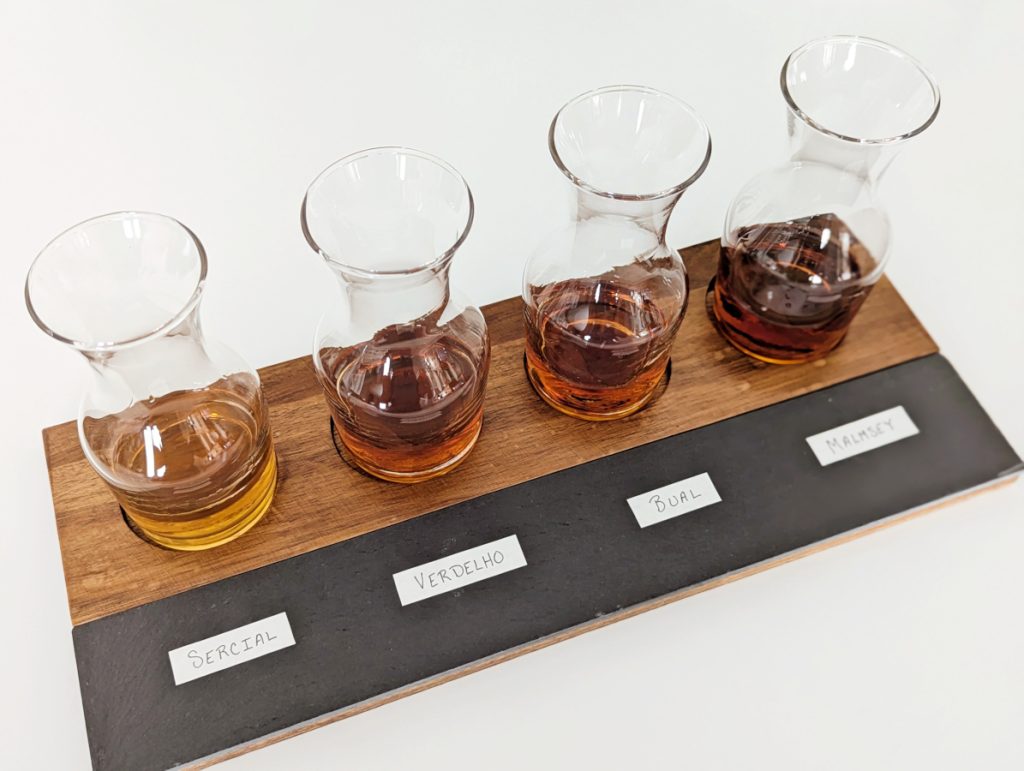Tasting Madeira Wines

Photo by Denise M. Gardner
Madeira wines were once the sought after wines of Americans, pre- and post-Revolutionary War. They carried through American culture into our first presidencies and well into the Gilded Era.
And then…
They disappeared.
Last month’s Sip & Swirl (A Wine. A Country. And a Story…) contains a more in depth review of Madeira wines, providing historical context to the wine that – figuratively – made America.
This month, I would like to explore what these wines taste like and what to expect if you buy a Madeira wine.
Remember, there are 4 noble grape varieties associated with Madeira wines:
- Sercial
- Verdelho
- Bual
- Malmsey (or Malvasia, which is a family of grapes)
All of these wines are fortified with added grape brandy. As the fermentation is arrested before completion, each of these wines carries some level of sweetness. Sercial is the least sweet and Malmsey is the sweetest.
The introductory, common Madeira is labeled as “Rainwater.” Technically, any of the grape varieties listed above can go into Rainwater Madeira wine. Though, most often, the bulk of Rainwater Madeira is produced from the Tinta Negra Mole wine grape variety. Tinta Negra Mole is not considered one of the noble varieties. Rainwater Madeira is somewhat of a toned-down version of any of the noble variety wines. The acidity is not as forthcoming, the sweetness is not as integrated, and the flavor is not as intense or rich as the varietal wines, discussed below. Nonetheless, it is a good introduction to Maderia wines, as it portrays the style and common Madeira wine flavor profile well.
Tasting Notes on the Four Noble Grape Varieties: Madeira Wines (Blandy’s)
5-Year-Old Sercial: This wine is a honey-yellow color, which may remind you of an aged white wine. Sercial, is the least sweet of the 4 noble variety Madeira wines. Nonetheless, there is noticeable sweetness as all 4 of these wines contain some sweetness. The acidity (sourness) shines through in this wine, making it quite bright and refreshing! Compared to Malmsey, a Sercial wine may seem out of balance because the acid really takes center stage on the palate. The acidity makes Sercial wines great apéritifs. The wine tends to be lighter bodied due to the higher acidity and lower sweetness levels. The flavors favor citrus notes, but also contain well-integrated hints of honey, nutty, and creamy flavors.
5-Year-Old Verdelho: This wine is significantly darker than Sercial and starting to lean more into that amber hue associated with many Madeira wines. It is slightly sweeter than Sercial. The acidity is still vibrant in Verdelho wines, but it tends to have better integration compared to Sercial wines. This means the acid doesn’t quite stick out the way it does in a Sercial wine. The dried fruit aromas and flavors are richer in Verdelho compared to Sercial. Some of that citrus pop in Sercial is toned down in Verdelho wines. It’s possible to get some dried peach or dried apricot essences blended in with the citrus flavors in a Verdelho wine. Also, it is a bit waxy, like fresh beeswax. Retains the creamy, caramel flavor well-known among Madeira wines.

Photo by: Denise M. Gardner
10-Year-Old Verdelho: Because Verdelho was the most commonly consumed variety during the time of the American Revolution, I decided to do a side-by-side comparison between a 5-year-old and 10-year-old Verdelho. The 10-year-old receives longer aging during production. On the palate, the acidity and sweetness integrate better, making the wine more harmonious. The sourness seems less angular. The flavors are richer with stronger notes of dried peach or dried apricot and candied citrus. These fruit notes are coupled with the creamy and caramel flavors associated with the 5-year-old Verdelho.
5-Year-Old Bual (or Boal): This wine is amber-hued and darker than the Verdelho. Compared to Sercial and Verdelho wines, Bual is noticeably sweeter. The wine is dominated by dried fruit, candied citrus, dried apple, and creamy, vanilla flavors. It certainly echoes flavors of tzimmes, a Jewish vegetable dish that is usually composed of baked carrots, squash, or additional root vegaetables mixed with warming spices, honey, and dried fruits. (This is a great side dish during the Fall months!) Also, the Bual wine has a deeper waxy flavor compared to Verdelho. This wine has more richness than the previous two varieties of the same age, making it more favorable as a dessert wine.
5-Year-Old Malvasia (or Malmsey): This variety has the deepest and darkest amber hue. Malmsey is certainly the sweetest and most concentrated Madeira wine of the wines tasted here. It even feels more viscous than the other wines. There is nothing that compares to a good glass of Malmsey! Flavors are dominated with caramelized and prune/raisin-like flavors. There are some hints of warming spices that hug the sweetness of this wine. There’s additional nuanced flavors in this wine including toffee candy, dark honey, and dried fruit. Save this one as a dessert wine.
When and Where to Have Madeira Wine
I like to have Madeira wines before dinner as an apéritif. It’s just a fun and fancy way to showcase the wines, getting the palate prepped for a delicious meal.
Pairing during the meal may seem tricky, but the dried fruit, warming spice, and caramel flavors are somewhat versatile. I know several people that have mentioned using Madeira to cook with or pair with mushroom dishes including sautéed mushrooms, mushroom tarts, and mushroom soups. The earthiness of the mushrooms tends to be a lovely contrast to the warm, comforting Madeiras. Try these pairings with Bual or Verdelho wines.
Some other soups that are popular in the Fall that I could envision with Sercial or Verdelho Madeira wines include butternut squash soup, carrot soup, spiced curries, and a powerful beef stew.
As fish is a primary staple on the island of Madeira, I wouldn’t hesitate to pair Madeira wines with fish-based entrées. This includes things like fish or seafood stew and tuna or trout filets.
Another classic pairing is with various cheeses. I’ve had several Portuguese meals that ended with cheese and Port; I wouldn’t hesitate to swap out Port for my favorite Madeira here.
Finally, many people enjoy Bual and Malmsey wines as a dessert-substitute or paired with desserts due to their sweetness levels. I really enjoy the flavor combination of Madeira with orange-flavored desserts, including things like orange cakes, orange-chocolate cake, and even citrus tarts. I think these pairings would be delightful. Malmsey wines will typically hold up to rich chocolate desserts, as well. Don’t hesitate to grab a good Malmsey to pair with a rich chocolate torte. Finally, nut based desserts are also good pairings: from baklava to pecan pie. A sweet, decadent Madeira wine is sure to hold up next to these classics.
Remember to have fun with food and wine pairings. Half of the fun is in the selection and conversation surrounding the pairing.
Bon appetite!

Photo by: Denise M. Gardner

